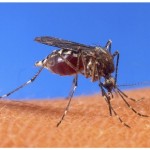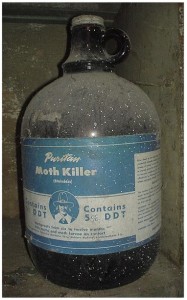In honor of a birthday today, I looked up some issues of scientific journals from this day in 1946. I noticed that publications in that year illustrate the theme that a silver lining can sometimes be found even in tragic events. Research articles published in 1946 reflect some of the astounding scientific advances of the time that were driven by military pursuits during the second World War. An example is shown below; this publication came out in the issue of Science covering Sept 14-20, 1946. The authors were part of the Naval Medical Research Institute (NMRI) in Bethesda, Maryland.
Two New Effective Insect Repellents, NMRI-201 and NMRI-448
 Researchers examined a library of small molecules for mosquito-repellent activity, and found that a couple of chemical compounds, molecules A and B, stood out from the rest of the pack as lasting longer on human skin even with sweating. They tried applying mixtures of these two chemicals to military personnel, and found that a 70:30 mixture of A:B was even more effective than either molecule alone. This mixture was named NMRI-201.
Researchers examined a library of small molecules for mosquito-repellent activity, and found that a couple of chemical compounds, molecules A and B, stood out from the rest of the pack as lasting longer on human skin even with sweating. They tried applying mixtures of these two chemicals to military personnel, and found that a 70:30 mixture of A:B was even more effective than either molecule alone. This mixture was named NMRI-201.

NMRI-201 was tested on military men in the jungle, and it was found to prevent mosquito bites for up to 11 hours, a record time for bug repellents as of 1946. However, some men experienced skin irritation due to NMRI-201, and animal studies indicated that the irritation was primarily due to molecule B. So researchers went back and tried to make some modifications to the formula. They found that they could replace molecule B with molecule C (above). The mixture of A and C was approximately as effective as the original mixture of A and B, but without any reports of skin irritation. This mixture was called NMRI-448.
Apparently, news of NMRI-201 reached Time Magazine in mid-1945, but this Science paper represents the full account of its development and the progression to NMRI-448.
 In retrospect, the advances made in insect repellants during WWII were historically huge. Originally intended to protect troops in the field, these bug repellants later made it to civilians as well. Along the same lines, the 1939 development of the insecticide DDT resulted in a Nobel Prize in 1948 for chemist Paul Hermann Muller. Compounds such as these have been dramatically instrumental in reducing certain life-threatening diseases such as malaria and typhus.
In retrospect, the advances made in insect repellants during WWII were historically huge. Originally intended to protect troops in the field, these bug repellants later made it to civilians as well. Along the same lines, the 1939 development of the insecticide DDT resulted in a Nobel Prize in 1948 for chemist Paul Hermann Muller. Compounds such as these have been dramatically instrumental in reducing certain life-threatening diseases such as malaria and typhus.


I was stationed at NMRI in 1946 and worked in parasitology on the study of schistosomiasis. I wonder if I might know the authors of the paper referred to the mixture as NMRI-448.
The authors of the paper give their names as L. A. Jachowski and M. Pijoan (I guess they didn’t give first names back then…). That would be really cool if you know them! ? Also, if you see this and get a chance, maybe send me an email – I would love to hear more about the work you did back then!